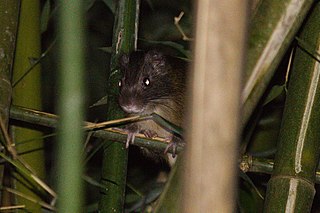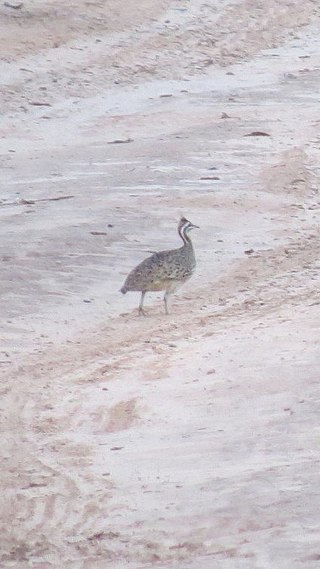
Felis is a genus of small and medium-sized cat species native to most of Africa and south of 60° latitude in Europe and Asia to Indochina. The genus includes the domestic cat. The smallest Felis species is the black-footed cat with a head and body length from 38 to 42 cm. The largest is the jungle cat with a head and body length from 62 to 76 cm.

The common sandpiper is a small Palearctic wader. This bird and its American sister species, the spotted sandpiper, make up the genus Actitis. They are parapatric and replace each other geographically; stray birds of either species may settle down with breeders of the other and hybridize. Hybridization has also been reported between the common sandpiper and the green sandpiper, a basal species of the closely related genus Tringa.

Jentink's duiker, also known as gidi-gidi in Krio and kaikulowulei in Mende, is a forest-dwelling duiker found in the southern parts of Liberia, southwestern Côte d'Ivoire, and scattered enclaves in Sierra Leone. It is named in honor of Fredericus Anna Jentink.

The Atlantic bamboo rat, or southern bamboo rat, is a spiny rat species found in humid tropical forests in Argentina, Brazil and Paraguay. It is the only member of the genus Kannabateomys.
The tuft-tailed spiny tree rat is a spiny rat species from Brazil south of the Amazon River, where it has been found in grassland and gallery forest. It is the only species in the genus Lonchothrix. Very little is known about this rodent. It is small with an average adult weight of about 138 grams. It is nocturnal and solitary in habits.

Ferreira's spiny tree-rat is a spiny rat species found in Bolivia, Brazil, Colombia, Ecuador, French Guiana, Guyana, Peru, Suriname and Venezuela. The etymology of the species name corresponds to the Latin word hispidus meaning bristly.
The tufted-tailed spiny tree-rat or furtive spiny tree-rat is a spiny rat species known from Amazonas, northwestern Brazil, where it is found in tropical rainforest. The species is arboreal.
The Pará spiny tree rat or Surinam spiny tree rat, is a spiny rat species found in Brazil.

Mesomys is a genus of South American spiny rats in the family Echimyidae.

Berlepsch's tinamou is a type of ground bird found in moist forest in northwestern Colombia and northwestern Ecuador.

The tepui tinamou is a type of ground bird found in montane moist forest on tepuis, in southeastern Venezuela.

Bartlett's tinamou is a type of tinamou found in lowland forest in South America.

The small-billed tinamou is a type of Tinamou commonly found in dry savanna in Amazonian South America.

The curve-billed tinamou is a type of tinamou commonly found in high-altitude grassland and shrubland habitats in the Andes of South America.

The quebracho crested tinamou is a species of tinamou found in dry forest habitats in Paraguay and northern Argentina in South America.

The chestnut-headed tesia is a small insectivorous songbird formerly of the "Old World warbler" family but nowadays placed in the bush warbler family (Cettiidae).

The blue-fronted fig parrot is a species of parrot in the family Psittaculidae. It is found in Salawati and the Bird's Head Peninsula in New Guinea. Its natural habitat is subtropical or tropical moist lowland forests.
The dusky spiny tree rat is a species of rodent in the family Echimyidae. It is endemic to Brazil.
The greedy olalla rat is a species of rodent in the family Echimyidae. It is found in Colombia and Venezuela. Its natural habitat is subtropical or tropical moist lowland forests.

The highlands punaré is a caviomorph rodent of South America from the spiny rat family. It is endemic to gallery forest, savanna and rocky outcrop habitats in Bahia State within the Caatinga ecoregion of eastern Brazil at elevations from 260 m to 1030 m. It sometimes nests and often takes refuge in crevices in rock formations, as means of both predator avoidance and moderating temperature extremes. The species tolerates a degree of habitat disturbance. Although hunted, it is considered common throughout its range. Its karyotype has 2n = 26 and FN = 48.














